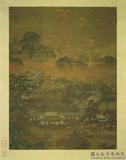宋劉松年畫羅漢 軸
推薦分享
資源連結
連結到原始資料 (您即將開啟新視窗離開本站)後設資料
- 資料識別:
- 故畫000099N000000000
- 資料類型:
- 繪畫
- 著作者:
- 劉松年
- 主題與關鍵字:
- 羅漢(應真、尊者) 佛道侍者 寒林.枯樹 竹 桃花 猿 鹿
- 日期:
- TIME STAMP:30-8月 -05
- 格式:
- 本幅 117x55.8公分
- 關聯:
- 故宮書畫錄(卷五),第三冊,頁88-89&秘殿珠林續編(乾清宮),頁76&故宮書畫圖錄,第二冊,頁103-104&劉松年(西元十二世紀末期至十三世紀初期)淳熙畫院學生,紹熙年待詔。錢塘人,居清波門外,人呼劉清波,又呼暗門劉。山水人物師張敦禮,而神氣清妙,時稱絕品。 劉松年同時所畫羅漢共三幅,此為其中之一幅。畫者倚桫欏樹,上有通臂猿摘石榴,一童持杖,以袂承果。用筆傅彩,皆極精妙,尤以佛頂圓光,及三樹枝柯掩映,繁縟精美,皆臻絕妙。羅漢在早期佛教?,是獨善其身的修行者,大乘佛教興起後,逐漸具備渡化眾生的菩薩特質。本幅畫一羅漢,濃眉高鼻,倚桫欏樹沉思,身側一小和尚以衣袖承接樹上長臂猿所摘之石榴,羅漢的袈裟圖案以泥金描繪,透過他頭後的圓光,尚能看見樹枝掩映,足見畫家功力。斑駁的樹幹和湖石表面,呼應著羅漢佈滿皺紋的面容。 尊者倚桫欏樹。上有通臂猿摘桃,一行童持杖,以袂承之。雙鹿馴遊。款「開禧丁卯(一二○七)劉松年畫」。有「內府書畫」「皇姊圖書」印。按「內府書畫印」凡六見:一見於唐盧楞伽十八羅漢冊(見喜龍仁中國畫第三冊圖八九下),一見於北宋趙令穰橙黃橘綠冊(見本書圖七○);一見於宋高宗書紈扇(為趙令穰橙黃橘綠冊對幅,未印);另三印即見於此三幅羅漢像中。盧楞伽羅漢冊,「內府書書」印鈐於左上角,「皇姊圖書」印鈐於右上角;趙令穰畫及宋高宗書,因係圓幅,「內府書畫」印皆鈐於正中上方。亦無「皇姊圖書」印。此三幅羅漢像,「內府書畫」印,皆鈐於左上方。而「皇姊圖書」印,第一幅鈐於左上方,在「內府書畫」印之下;第二、三兩幅,則鈐於右上方。據此,則知「內府書畫」印,鈐蓋有定位,而「皇姊圖書」印無定位。亦即證知「內府書畫」印在「皇姊圖書」印之前。故「內府書畫」印在時間上之上限為開禧丁卯(一二○七),下限為元貞乙未(一二九五),極可能為宋寧宗收藏印。&Liu Sung-nien, a native of Chekiang, was a student in the Painting Academy and later served as Painter-in-Attendance during the Shao-hsi reign period(1190-1195). He lived outside the Ch’ing-po gate so people called him Liu Ch’ing-po. He was also called An-men-liu. He learned the art of painting landscapes and figures from Chang Tun-li. Liu’s paintings often are said to have a pure and exquisite spirit and at the time they were considered second-to-none. This is one of three Lohan paintings by this artist, all dated 1207, in the Palace Museum. This picture depicts a lohan leaning against a so-lo tree. Above him long-armed monkeys are picking pomegranates and passing them down to a youth with a long staff, who collects them in his coat. Two deer stand tamely at his feet. The handling of the brush and the use of colour in this work are very fine;especially in the lohan’s halo and the beautifully intricate branches of the trees. ──The first of these three hanging scrolls depicts a Buddhist sage, or lohan, leaning on a branch of a sala tree. Above him a monkey holds a peach in its outstretched arms; a boy holding a staff prepares to receive it. A pair of tame deer stand in the foreground. The painting is signed “In the ting-mao year of K’ai-hsi(1207), painted by Liu Sung-nien.” In the second painting --The lohan sits holding a staff. A priest questions him about the meaning of a sutra scroll. All three scrolls bear the seals “Nei Fu Shu Hua” and “Huang Chieh T’u Shu”. The seal “Nei Fu Shu Hua” appears on six paintings: “Eighteen Lohans” by Lu Leng-chia of the T’ang (see Hsi Lung-jen, Chung-kuo hua, Vo1. Ⅱ, pl. 89b), “Orange Groves in Bloom” by Chao Ling-jang of the Northern Sung (see No. 70), a round fan of calligraphy by the Sung emperor Kao-tsung(the facing leaf to Chao Ling-jang’s painting; unpublished), and the three paintings by Liu Sung-nien now under discussion.
- 管理權:
- 國立故宮博物院
授權聯絡窗口
- 國立故宮博物院圖像授權、出版授權、影音資料授權-申請流程說明
http://www.npm.gov.tw/zh-TW/Article.aspx?sNo=03003061






